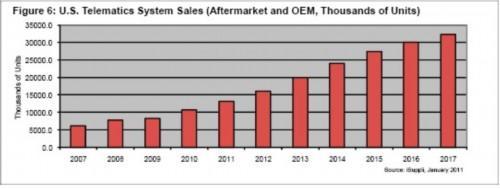U.S. Continues to Lead OEM Telematics Market
 According to iSuppli Corporation, the total supply of automobile telematics systems in the US will continue to be higher than other countries in 2011, and Western Europe will be ranked second.
According to iSuppli Corporation, the total supply of automobile telematics systems in the US will continue to be higher than other countries in 2011, and Western Europe will be ranked second. In 2011, including the OEM-installed systems and aftermarket, the total US telematics system sales volume will increase by 22.6%, from 10.7 million units in 2010 to 13.1 million units, as shown in Figure 6. It will increase to 32.3 million units by 2017.
The U.S. telematics market is the largest in the world, and this status will remain at least until 2017. The automotive telematics industry in the United States has a history of more than 10 years. Ford Motors and General Motors began selling the first batch of such systems in 1996.
By 2011, the overall US telematics system placement rate will exceed 100%, and many cars will have embedded and mobile device communication links. In fact, since the 2009 model year, most of GM’s cars are equipped with the new OnStar system with Bluetooth, using the elements of both systems.
At present, telematics of mobile devices is the largest telematics field in the U.S. market, and at the end of 2009 it exceeded embedded telematics. Mobile telematics relies on the connection of smart phones or other mobile devices to enable communications, while embedded telematics is built into the car's body. Mobile telematics occupies an advantage not only because of strong growth in Ford cars and other OEMs' cars, but also because many cars with embedded telematics are increasingly equipped with Bluetooth systems, enabling mobile telematics. deal with.
Overall, the sales volume of OEM mobile device telematics systems in 2017 will increase from 4.8 million units in 2009 to 16.2 million units, with a compound annual growth rate of approximately 16.5%.
In contrast, sales of OEM-embedded telematics systems in 2017 are expected to be slightly higher than 12.4 million units, compared to approximately 2.5 million units in 2009, and the compound annual growth rate for 2009-2017 was 22.2%. With nearly 100% of GM equipped with embedded telematics, the number of US models that use embedded telematics has stopped growing. However, with the introduction of embedded telematics by Toyota/Lexus and the launch of a new Mercedes-Benz service, the proportion of telematics embedded in the 2011 model year is expected to increase.
Because of the high cost of hardware and infrastructure, embedded telematics is less popular than mobile telematics, including Bluetooth Human Interface (HFI). Japan is currently in a leading position in the field of telematics service mobility solutions, and the United States ranks second with Ford Sync.
Thanks General Motors
As a result of GM’s efforts, the United States leads other regions in telematics deployment. For 10 years, GM has been the backbone of telematics deployment. General Motors decided to make OnStar the standard configuration of all models since 2009, which puts pressure on its peers and has entered the telematics market. Until now, other OEMs that offer embedded telematics technology are BMW and Mercedes. However, as the two depots only produce luxury premium cars, their impact is limited.
GM now sells about 2 million cars each year with embedded telematics, compared with about 3 million in 2008. The company’s competitors were forced to respond. Ford Motor launched Sync in late 2007 and later began providing telematics technology.
The Slip on Flange is the flange of steel pipe with neck, which is the flange connecting steel pipe, pipe fittings and so on into the flange through fillet weld. The neck height of the flat welding flange with neck is lower, which improves the stiffness and bearing capacity of the flange.
Slip On Boss Flange,Slip On Plate Flange,Slip On Hubbed Flange,Slip On Puddle Flange
Jinan Xintai Forging Co., Ltd , https://www.xtdzflange.com